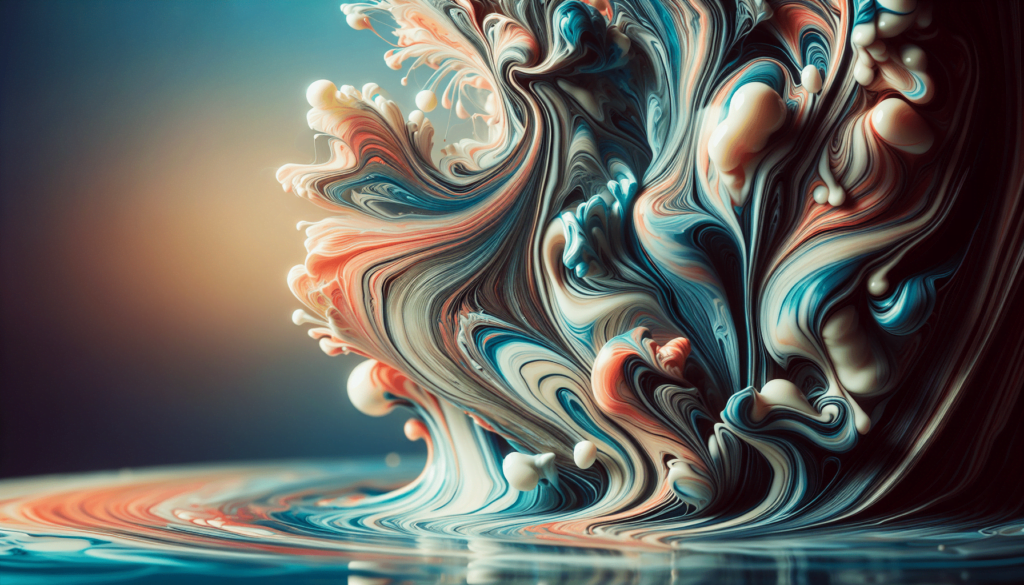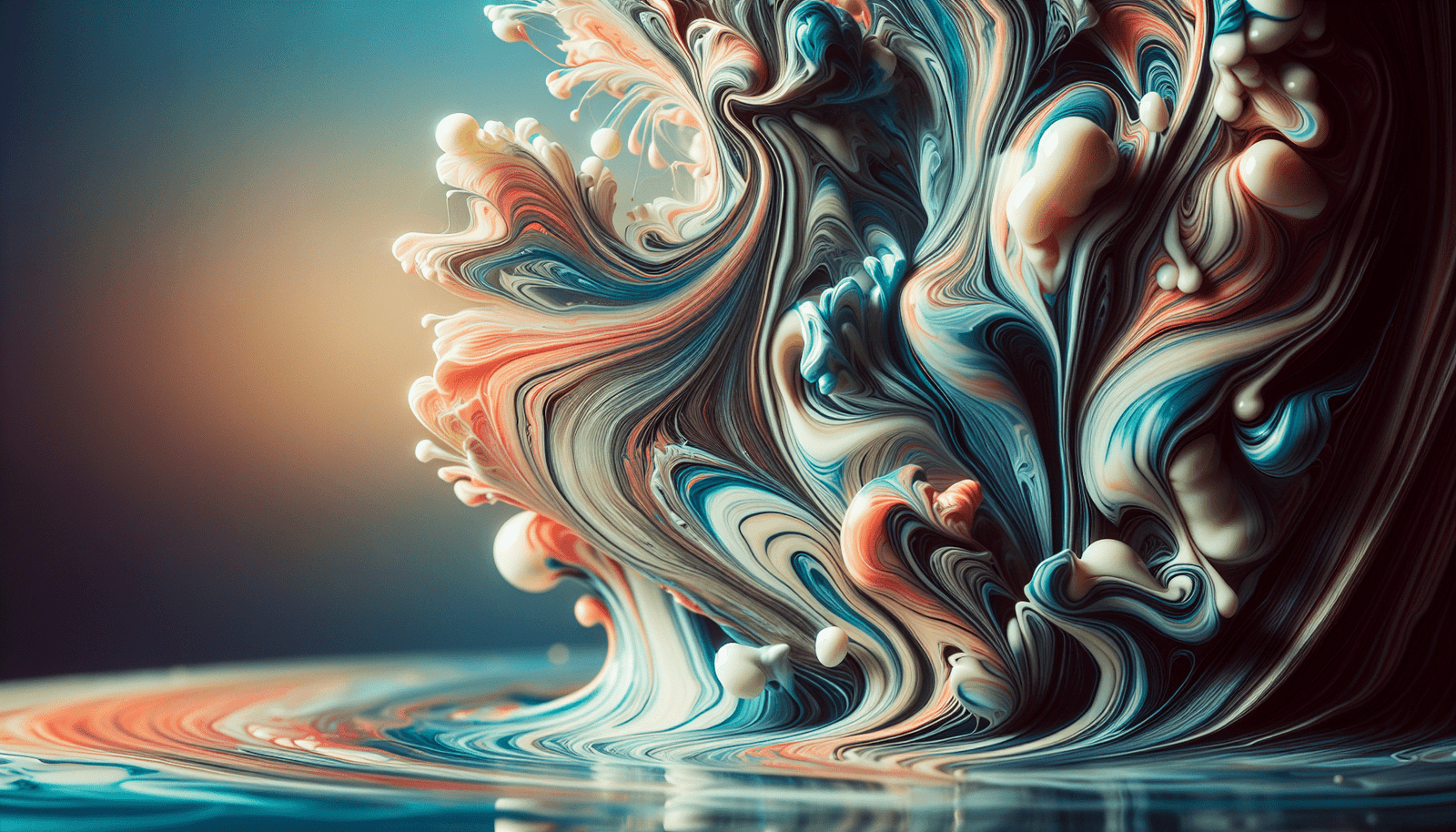Discover the captivating world of Paint Pouring – a mesmerizing DIY art technique rooted in the work of Mexican muralist David Alfaro Siqueiros. Secrets of Paint Pouring Revealed explores the science of Fluid Dynamics and offers practical tips to help you create vibrant, marbled paintings with stunning patterns. Uncover the secrets behind this trendy art form and learn how to manipulate fluid media to create your own masterpieces.

Paint Pouring Overview
Paint Pouring is no ordinary painting method; it’s a dance of colors, a blend of science and creativity. Imagine pouring different hues together and watching them meld into stunning, intricate patterns right before your eyes. The beauty lies in the unpredictability—no two paintings will ever be alike. You might have come across terms like ‘cells’ or ‘bubbles’ in the context of this art. These refer to the organic shapes that form as the paints interact, influenced by factors like density and fluid mediums.
What is Fluid Art?
Fluid Art is a broader term that encompasses various techniques where fluid paints are manipulated to create art. It’s like the sibling to traditional painting, breaking away from the boundaries of brushes and canvases. Paint Pouring specifically refers to the technique of pouring paint directly onto the canvas and letting nature (with a bit of science) do its magic.
Origins
It’s hard to imagine, but this modern-looking art form has roots stretching back to the early 20th century. The technique was discovered accidentally by David Alfaro Siqueiros, a Mexican muralist and activist, who didn’t wake up one day and decide to revolutionize art. Instead, it was a happy accident.
A Happy Accident
In the 1930s, Siqueiros was experimenting with layering various types of paint. The different densities and interactions created unusual patterns. Sometimes, great discoveries are made without intention, and Fluid Art is a perfect example. Siqueiros noted the unique shapes and textures that emerged, laying the groundwork for what would later evolve into Paint Pouring.
Scientific Basis
If you think art and science don’t mix, think again. The mesmerizing patterns in Paint Pouring are deeply rooted in Fluid Dynamics, a branch of physics that studies the behavior of fluids (liquids and gases) in motion.
Fluid Dynamics and Paint Pouring
Fluid Dynamics can explain why certain paints create those beautiful cells or why some colors blend seamlessly while others sharply contrast. This is where the magic of science meets creativity. Different pigments have varied weights and densities, so when they’re mixed, they interact in unique ways. The medium you choose to mix with the paint will also affect the result, making each piece a miniature scientific experiment.
The Science of Cells
The formation of cells in Fluid Art can be attributed to the phenomenon known as the Marangoni effect. This is where variations in surface tension cause fluids to move and create those fascinating cell-like shapes. Now, aren’t you glad you paid attention in your science classes?
Materials and Techniques
You don’t need a warehouse full of supplies to get started with Paint Pouring. A few key materials and a basic understanding of techniques will set you on your way to creating your own masterpieces.
Basic Materials
Here’s a quick rundown of what you’ll need:
| Material | Purpose |
|---|---|
| Acrylic Paint | Main medium; choose various colors for diverse effects |
| Pouring Medium | Helps paint flow better and enhances cell formation |
| Canvas | Your work surface; can be framed or unframed |
| Cups or Bottles | For mixing your paints and mediums |
| Palette Knife | Useful for spreading paint or creating textures |
| Heat Gun/Torch | Optional; helps in creating cells and bubbles |
Choosing the Right Paint
When selecting paint, keep an eye out for quality. While you can use cheaper paints for practice, investing in good acrylics will make a noticeable difference in your final piece. Pigment density affects interaction, so experimenting with different brands and types can yield varied results.
Mixing Paints
Pouring Mediums are crucial for getting the right consistency, allowing the paint to flow while maintaining its integrity. Start by mixing your paints with the medium, usually in a 1:1 ratio, though some variations might be required depending on the paint and medium used.
Pouring Techniques
Different techniques yield different results. Here are a few to get you started:
- Dirty Pour: Mix several colors in one cup and pour directly onto the canvas.
- Flip Cup: Fill a cup with multiple colors, place the canvas on top of the cup, and then flip it over.
- Swirl: Pour colors individually in a swirl pattern and then manipulate the canvas to spread them.
Each technique offers a unique aesthetic, and part of the fun is seeing what emerges.
Creating Cells and Bubbles
If you want to get those intriguing cell-like patterns, a few drops of silicone oil in your paint mix can do wonders. Apply a heat gun or a torch to the canvas to bring these cells to the surface.

Practical Tips
Now that you have a grasp of the basics, let’s delve into some practical tips that can help you master your craft and get the best results.
Control the Environment
Temperature and humidity can affect how your paint behaves. Ideally, work in a well-ventilated, climate-controlled room. This ensures that the paint dries evenly and minimizes the risk of cracking.
Test Swatches
Before you dive into your main project, try making small test swatches. These small trials can help you understand how different paints and mediums interact, saving you from potential mishaps on the main canvas.
Layering Matters
When layering paints, start with the heaviest pigments and work your way up to the lighter ones. This helps in creating the desired flow and avoids muddying the colors.
Clean Up
Paint Pouring can be messy. Protect your work surface with plastic sheeting or newspapers, and always have some wet wipes or cloths handy.
Further Learning
Learning Paint Pouring is a continuous journey. As you become more comfortable with the basics, there are endless advanced techniques to explore. Future posts will delve deeper into specific aspects like mixing paints, advanced pouring techniques, and how to create Fluid Art on a budget.
Join a Community
One of the best ways to learn is by joining a community of like-minded enthusiasts. Whether it’s online forums, local workshops, or social media groups, sharing your experiences and learning from others can be incredibly rewarding.
Experiment and Document
Don’t be afraid to experiment. Keep a journal or a digital log of your work, noting the materials used, techniques tried, and the outcomes. This can serve as a valuable resource for future projects.
Acknowledgments
Special thanks to Gary Nave, whose insights into Fluid Dynamics have enriched our understanding of Paint Pouring. Gary’s expertise has helped decode the science behind the art, making it accessible even for newbies.
Conclusion
There you have it—the secrets of Paint Pouring revealed. From its accidental beginnings to the scientific principles that govern it, and the practical tips to get you started, you’re now ready to embrace this mesmerizing art form. Whether you’re a seasoned artist or just dipping your toes into the world of Fluid Art, there’s always something new to learn and discover. So, grab your materials and start experimenting—you never know, your next piece might just be a masterpiece waiting to happen!

